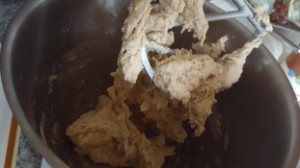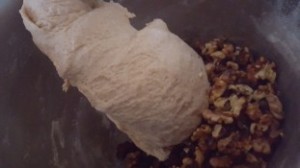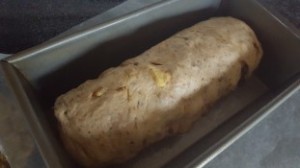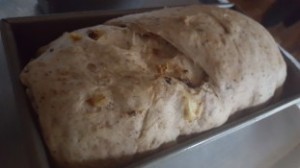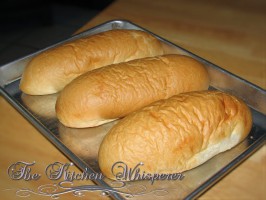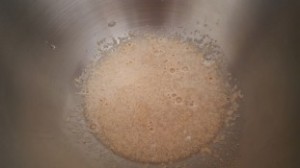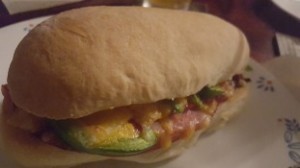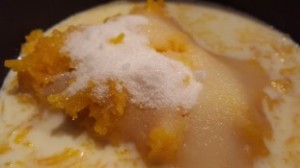#24, Bagels
 I’ve been wanting to do a recipe for bagels for quite a while, we’ve been stocking them more often in the pantry again, always a favorite breakfast snack! But there have been two distinct notes of opposition preventing me from doing this: first, of course, find a couple day period to spend making them, a pain when one keeps getting distractions or days that make you just not want to do anything. But the second, and bigger issue, is my recipe book’s requirement for “High Gluten Flour.” And no, this doesn’t mean just bread flour, high-gluten is a step higher than that and apparently instrumental to making those perfectly chewy bagels.
I’ve been wanting to do a recipe for bagels for quite a while, we’ve been stocking them more often in the pantry again, always a favorite breakfast snack! But there have been two distinct notes of opposition preventing me from doing this: first, of course, find a couple day period to spend making them, a pain when one keeps getting distractions or days that make you just not want to do anything. But the second, and bigger issue, is my recipe book’s requirement for “High Gluten Flour.” And no, this doesn’t mean just bread flour, high-gluten is a step higher than that and apparently instrumental to making those perfectly chewy bagels.
But apparently no one has it in stores, at least not the ones I’ve tried near me, and it is flipping pricey to buy online JUST for a bag of flour. So the thought was doomed, left to be procrastinated on for who knows how long. Thankfully, though, I ended up catching an episode of America’s Test Kitchen where they made, gasp, bagels! In it they DID use bread flour, or mentioned it was still a viable substitute for their recipe, helping get my brain back on track to the idea of making these holey goodies. Found a recipe online that actually STARTED with the ATK recipe but made his own manipulations to get an end result that was a little more classic and refined [plus without all those extra little odd steps they do in the show, which makes an awesome recipe yes but not a very classic one].
 A few notes, this IS one of the bread recipes where, much like pretzels, the proofed dough is dunked into a boiling water solution mixed with baking soda to gelatinize the outer layer for an even thicker and distinct crust after baking. The dough itself is made VERY firm and stiff; it is highly advised you do NOT try to man up to knead it and just use a stand mixer instead. Because even THOSE will be struggling to whip it around. And I mentioned the special ingredient of high gluten flour, but there’s another one: Malt Powder or syrup. Apparently they’re used as the sweet aspect in lots of bagel recipes, both for the yeast to eat and to add an additional edge of flavor to the final product [likely a continued nod to the older times where some bagel makers just used some cheap available leftover materials from their or other beer making]. The powder itself is sort of in the same category as the flour, likely needing to order it, but one can find Barley Malt Syrup rather easily in stores, which I LOVE using by the way. For anyone who’s made beer and had to start out using the syrups and powders alongside the malt, they know the concentrated almost-molassasey goodness that this offers! Need to find some other cool things to mix it into… oh, and fair warning, this mofo is STICKY as all hell. No matter what it will not just fall off anything naturally, so be warned with pouring!
A few notes, this IS one of the bread recipes where, much like pretzels, the proofed dough is dunked into a boiling water solution mixed with baking soda to gelatinize the outer layer for an even thicker and distinct crust after baking. The dough itself is made VERY firm and stiff; it is highly advised you do NOT try to man up to knead it and just use a stand mixer instead. Because even THOSE will be struggling to whip it around. And I mentioned the special ingredient of high gluten flour, but there’s another one: Malt Powder or syrup. Apparently they’re used as the sweet aspect in lots of bagel recipes, both for the yeast to eat and to add an additional edge of flavor to the final product [likely a continued nod to the older times where some bagel makers just used some cheap available leftover materials from their or other beer making]. The powder itself is sort of in the same category as the flour, likely needing to order it, but one can find Barley Malt Syrup rather easily in stores, which I LOVE using by the way. For anyone who’s made beer and had to start out using the syrups and powders alongside the malt, they know the concentrated almost-molassasey goodness that this offers! Need to find some other cool things to mix it into… oh, and fair warning, this mofo is STICKY as all hell. No matter what it will not just fall off anything naturally, so be warned with pouring!
Recipe 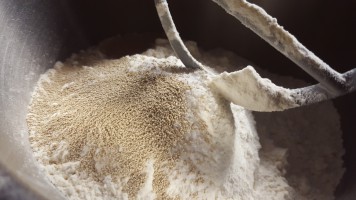 6 cup High Protein/Gluten or Bread Flour
6 cup High Protein/Gluten or Bread Flour
2 ¼ tsp Dry Yeast
1 Tb Kosher Salt
1/3 cup + 1 Tb Barley Malt Syrup or 2/3 cup Barley Malt Powder
2 cup Hot Water [88-100F]
1 Tb Baking Soda
Desired Toppings, if any
Egg White Wash [if topping]
Directions
- Combine Flour, Yeast, Salt, and Barley Malt Powder [if using] in stand mixer

- If using 1/3 cup Barley Malt Syrup, mix with Hot Water to dissolve, slowly streaming into the flour mixture while mixing on low speed [using paddle attachment]

- Once all loose flour has come together into a single mass, exchange paddle for dough hook and start beating around the dough on medium speed
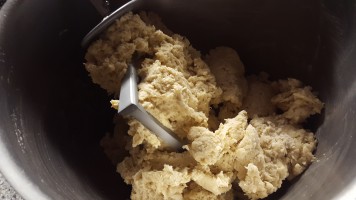
- Mix for at least 10 minutes, and yes your mixer WILL be working hard to do this, until your sturdy dough is smooth and elastic
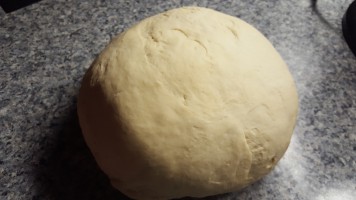
- Plop this on counter, loosely covering with plastic wrap or damp towel, and let rest at least 5 minutes to relax
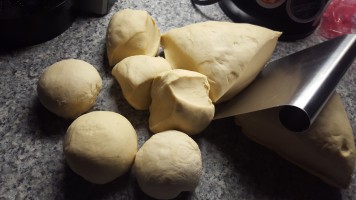
- Divide into 12 even-sized pieces. Placing a piece between your palm, fingers bent like a claw, and the counter surface [or if it has NO traction like my counter, your other palm], roll the dough rapidly in circles until it forms a smooth boule. It can help to tuck parts of it into the back like with regular boule-making technique at first
- Take each ball, gently pushing a hole straight through the center with your finger/thumb, and begin working this hole out to at least 1½” wide by slowly turning and pressing evenly with your thumb [that whole “spinning around your finger” trick probably DOES work, but only if the dough is absolutely perfect to start out with]. Alternately, one can roll the dough into an even log and wrap around your palm, re-connecting the ends into a perfect circle. Good luck

- Transfer to cornmeal-dusted pan, cover with plastic and move to refrigerator overnight

- The next day, take dough out and prepare your water bath. Combine 1 gallon water, the 1 Tb Malt Syrup, and Baking Soda, bringing to a boil

- Dip 3-4 doughnuts into the water at a time, leaving to boil on one side for one minute before turning over for another minute
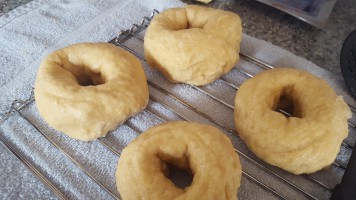
- Transfer to a cooling rack to drip for a bit and then to another cornmeal-lined baking sheet and repeat with remaining dough. As this is going, preheat oven to 450F
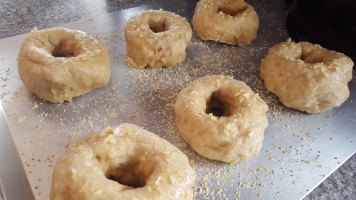
- If sprinkling any toppings [I myself used a Lemon Flake Sea Salt on some], brush the tops and sides of your bagels with Egg Wash [1 tsp of water mixed w/ one egg white vigorously], then sprinkle as generously as desired, patting ingredients down and into it afterwards
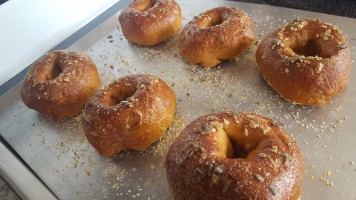
- Move into oven, baking at least 15-20 minutes, turning 180 degrees halfway through cook time
- Once deep golden brown and baked through, remove
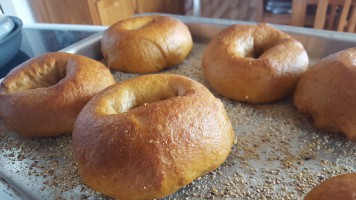
- Let cool half an hour before use or, if you’re cool, cut open immediately and cover those hot insides with butter and/or a schmear of cream cheese
- Enjoy
 What Have I Learned This Time?
What Have I Learned This Time?
That I still need more work with shaping, these bagels were a pain trying to keep even and ‘perfect’ looking. At least those rough edges softened up by the final product through proofing and baking, but I may have to try the ‘roll and wrap’ technique for shaping if I ever do this again.
Bagels definitely do NOT need egg wash if there’s no topping; I much prefer their color when baked as-is, the others made me nervous of being in too long.
The benefits of using a slightly damp towel when resting certain doughs; the bagel dough definitely started to get one of those firm skins on parts of it before shaping, which made the process itself that much more difficult. I feel like it developed one rather fast too. Sadly I hadn’t noticed the ‘damp towel’ instruction in the recipe [and it might have just been in another one that I read earlier actually], but it definitely would have helped here.
Any Thoughts?
The end result comes reminiscent of pretzels… not surprising given the similar boil-bath before baking. Big, chewy, and for once with a crunchy exterior when eaten close to fresh, it’s a good version of a bagel. Can’t wait to try one in New York in a month or so to do a proper comparison.
Does the Dough Like Me Yet?
It still thinks I need to work on my massage technique…














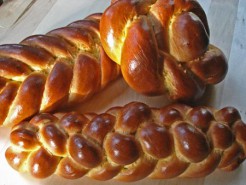
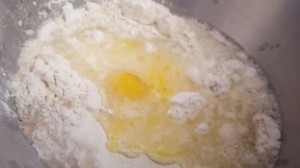
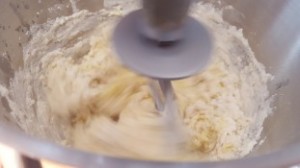

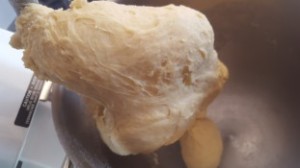

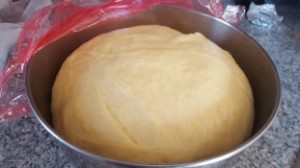




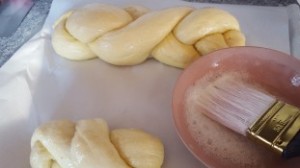



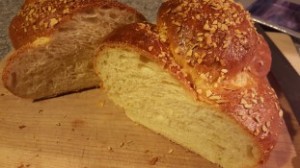
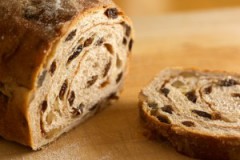
 h of course I don’t actually HAVE any raisins… which is why we improvise, there being quite the simple solution here. It WAS a good way to use up all the leftover dried fruit I had from my yearly fruitcake making. With luck, my mixture of dates, figs, dried apples and walnuts, matched with this homemade recipe, can put the many horrible memories of childhood daycare cinnamon bread ‘snack times’ to proper shame.
h of course I don’t actually HAVE any raisins… which is why we improvise, there being quite the simple solution here. It WAS a good way to use up all the leftover dried fruit I had from my yearly fruitcake making. With luck, my mixture of dates, figs, dried apples and walnuts, matched with this homemade recipe, can put the many horrible memories of childhood daycare cinnamon bread ‘snack times’ to proper shame.


